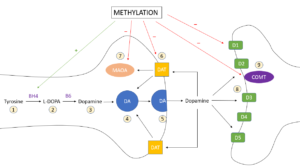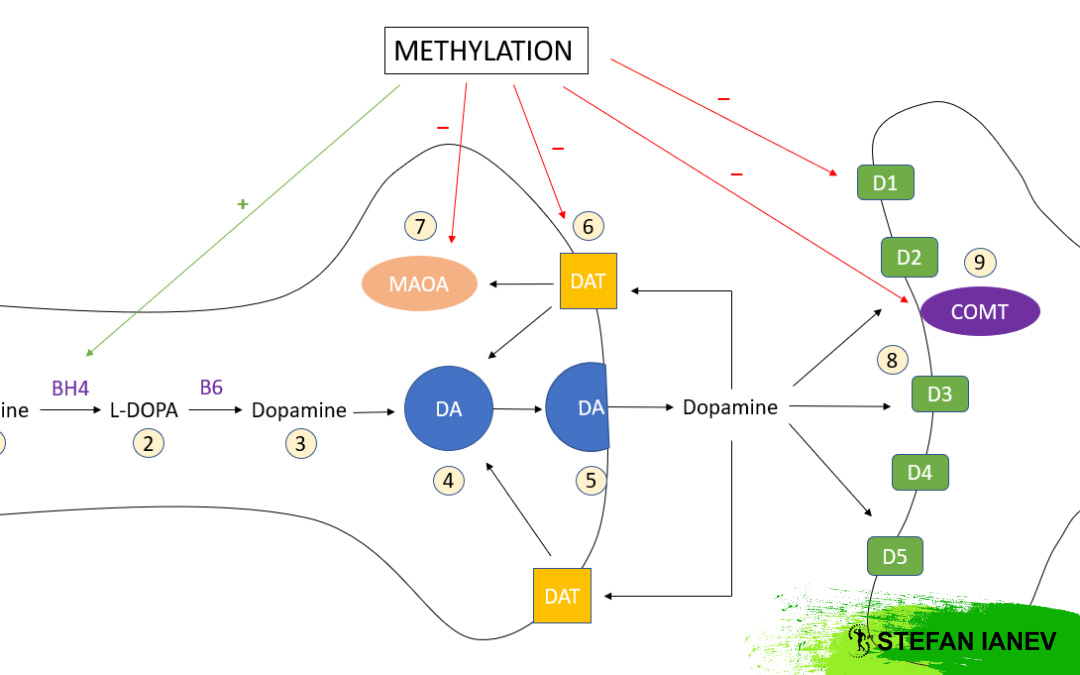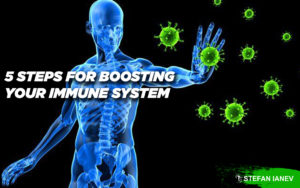In part 1 of this of this article we discussed the role of neurotransmitters and how they affect our mood, energy, motivation and personality.
We also looked at how neurotransmitters are synthesised, transported and broken down.
While there are hundreds of neurotransmitters, only a handful dominate neurotransmission. This includes the monoamine neurotransmitters dopamine, noradrenaline, and serotonin, as well as several others such as glutamate, GABA, and acetylcholine.
Neurotransmitters can be either excitatory, inhibitory or both. Most of the primary neurotransmitters are also neuromodulators in that they can directly stimulate or inhibit other neurotransmitters.
To keep things simple I generally look at the ratio or excitatory to inhibitory neurotransmitter activity. That means someone can either have excess, balanced or low levels of excitatory relative to inhibitory neurotransmitter activity.
If you recall from part 1 neurotransmitter activity is generally dominated by reuptake and breakdown, not the amount of neurotransmitter present. The activity of reuptake transporters and enzymes which breakdown our neurotransmitters such as MAOA and COMT is genetically predetermined.
Luckily for us, due advancements in the field of epigenetics, we now know that we can modulate genetic expression of various proteins and enzymes through targeted nutrient therapy. This is a very exciting and emerging field of study.
One of the primary processes that regulates genetic expression is methylation. Methylation is the process of adding a methyl group (one carbon atom bound to 3 hydrogen atoms) to an enzyme, protein, or gene.
Adding a methyl group to a DNA molecule either increases or reduces the expression of that gene. Typically DNA methylation reduces gene expression while DNA acetylation increases gene expression. The two process are generally in competition.
Continuing on with our example from part 1, lets take a look at how methylation regulates dopamine neurotransmission.

Figure 1 The rugulatory role of methylation in dopamine neurotransmission.
As you can see from above methylation is involved in every key regulatory step of dopamine neurotransmission.
Firstly methylation is required for the synthesis if BH4 which is a cofactor in the conversion of tyrosine to L-Dopa. BH4 is also required for the synthesis of all the other monoamine neurotransmitters.
Secondly methylation reduces genetic expression of dopamine reuptake transporters, and also re-uptake transporters for other neurotransmitters. That means more of the neurotransmitter will be available in the synapse to bind with receptors.
Thirdly methylation reduces the genetic expression of enzymes that break down our neurotransmitters like MAOA and COMT. This again makes neurotransmitters stick around longer and increases neurotransmitter activity.
Interestingly enough the COMT enzyme is a methyl dependent enzyme which attaches a methyl group to dopamine, noradrenaline, adrenaline, and other catechols like Estrogen. When dopamine, noradrenaline, and adrenaline are methylated they become inactive.
However, the role of methylation in reducing the genetic expression of COMT by DNA methylation seems to have a stronger affect on COMT activity than methyl acting a substrate for COMT. Studies have shown that undermethylation leads to increased COMT expression and reduced dopamine levels.
I also want to point out that methylation generally reduces receptor sensitivity which reduces neurotransmitter activity. If you think about it that makes sense because if you have excess neurotransmitters lingering around the body tries to normalize neurotransmission by reducing receptor binding.
Remember neurotransmitter activity exists on a bell curve. Having too much dopamine for example has been shown to reduce cognitive function while having too much serotonin increases anxiety. In other words the neurotransmitters begin to exert the opposite effect when they are in excess.
None the less, the overall impact of methylation is that it increases activity of most neurotransmitters including dopamine, serotonin, noradrenaline, glutamate, and acetylcholine. This effect is further compounded by genetics SNIPs of enzymes like MAOA and COMP.
While the methylation cycle occurs billions of times per second in every cell of the human body, because of genetic SNIPs, the speed of the cycle is slowed down in some people, while in others it’s overactive. A persons methylation status is largely genetically predetermined.
Generally undermethylated people will have lower neurotransmitter activity, while those that are overmethylated will have excess neurotransmitter activity. This means that under and over methylators will have very different nutritional requirements when it comes to optimizing their brain chemistry.
In part 3 of this article we are going to take a look at the how the methylation cycle works, what nutrients are involved, and the best ways to assess your methylation status.






